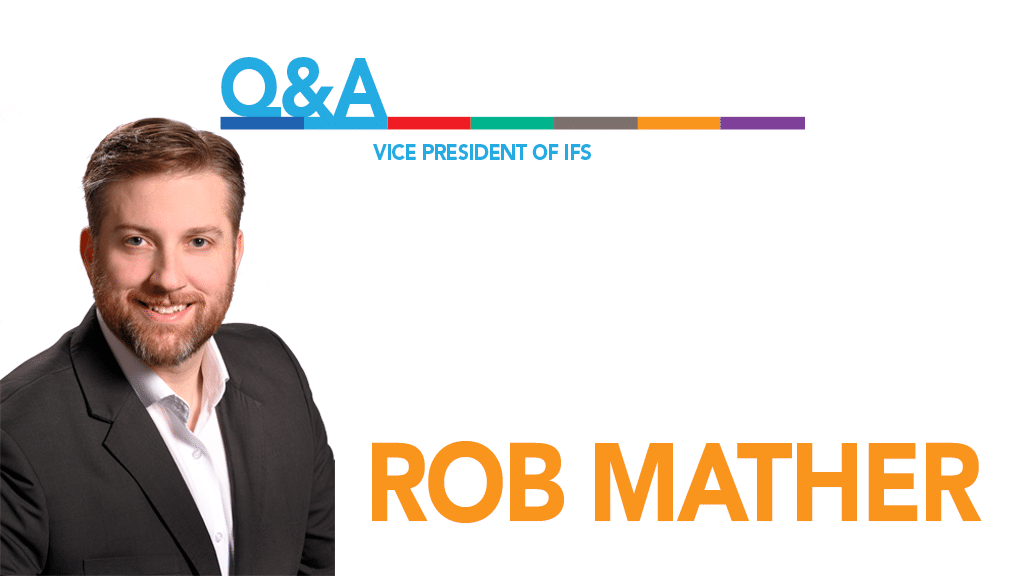As vice president, aerospace and defense industries, Rob Mather is responsible for leading the charge on IFS’ global A&D industry marketing strategy, while also supporting product development, sales and partner ecosystem growth. Rob has more than 15 years’ experience in the A&D sector, starting out in the field and having held a number of strategic R&D, presales and consulting positions at IFS, Mxi Technologies and Fugro Aviation. ATR’s Ian Harbison sat down with Mather to get his input on key issues in aerospace today.
ATR: Now that the industry is continuing to recover from the COVID-19 pandemic, what are the biggest challenges?
Mather: One of the most serious is labor shortages. During the crisis, many very experienced people decided this was an opportunity to change career or take early retirement. The result is significant skills shortages right across the industry. The age gap was already a growing problem, but it has been accelerated by events, especially as fewer younger people are seeing aviation as a career opportunity.
This is particularly true for line maintenance, where perhaps the best mechanics can be found, as the workload is constantly changing, requiring good troubleshooting skills and a flexible mindset to solve problems within the tight constraints of a turnaround time. Base maintenance tends to follow a process with set procedures and other people are always on hand in the hangar to assist.
ATR: What can be done to help, to fill the gap before newly trained people arrive in adequate numbers?
Mather: The creative use of integrated automation to improve overall efficiency offers the best solution and there are available technologies that can offer useful assistance right now.
For example, artificial intelligence (AI) and machine learning (ML) are both being used in wider applications.
An IFS pilot program with Icelandair Technical Services some years ago used ML and sensor data to predict failure down to individual serial numbers across a range of components. This has the effect of avoiding sudden, unanticipated failures and thereby increases the availability of the asset.
However, despite all the talk of predictive maintenance, in 2021 Lufthansa Technik estimated that only 50 of over 5000 airlines globally were running a true predictive maintenance program. At the same time Airbus reported that only about 10 percent of the global A320 family fleet were part of their predictive maintenance program.
There are a number of factors contributing to this slow uptake. Currently, maintenance intervals and life-limits are based on a worst case scenario, so some remaining useful life is always left on the table. To reduce the margins needs massive amounts of data but information is siloed. Airlines continue to be very protective of their information, so they have to be persuaded that sharing has real value. Likewise, OEMs are equally reluctant to share their data with other OEMs (although there are some recent positive signs of collaboration).
A good example of this is LATAM, which seeing that value, has signed up to the Rolls-Royce Blue Data Thread. The engine supplier is collecting data from multiple sources, such as engine health monitoring and configuration information from airline maintenance management systems, contextual real-time engine flying condition and other data sources including MRO data from Rolls-Royce engine facilities. IFS has automated the sharing of the data critical for Rolls-Royce to re-life its engine parts, moving from that worst case scenario to true-lifing of the engine. IFS has also taken a broader scope to inject the updated lifing back into the maintenance system and project forward off of new rates.
ATR: Another example?
Mather: Mobility. This is really about paperless maintenance that provides engineers with the ability to make decisions in real-time, provide agility, more time hands on metal, but also a faster time to resolve the problem. However, just giving an engineer an iPad doesn’t make them mobile, there needs to be a lot a process change across the maintenance organization, from engineering, to materials, to maintenance operations control, to Flight Ops.
ATR: Your final pick?
Mather: Augmented reality (AR) and light detection and ranging (LIDAR,) as they overlap and complement mobility.
AR is usually associated with training, while LIDAR is generally known from various special mapping applications in aviation maintenance such as drone inspections and dent detection.
In IFS Remote Assistance, a mechanic can connect live via video, showing a problem in real-time from a remote location to a maintenance center. The problem can be analyzed and the engineer or senior technician on the other end can provide instructions/information as an overlay in AR.
The FAA released guidance for remote virtual inspections as part of aircraft certification in 2020. If this was extended to certain maintenance inspections, it could have a massive impact on staffing models, with mechanics able to report in to a 24/7 centralized inspection department, which would have a full record of the event, including imagery.
As LIDAR is now available on smartphones and tablets, it also has an immediate application for non-critical defects and rough measurements, perhaps measuring a tear in a seat cover. The beauty is that it’s not just a manual transcription of what the technician saw on the measurement device, the measurement scan itself is logged, and stored.
ATR: Final thought?
Mather: Frost & Sullivan estimates that using technologies like these that are available today could generate between $5-$10 per passenger. To put that into context, Delta Air Lines carries over 200 million passengers a year.
